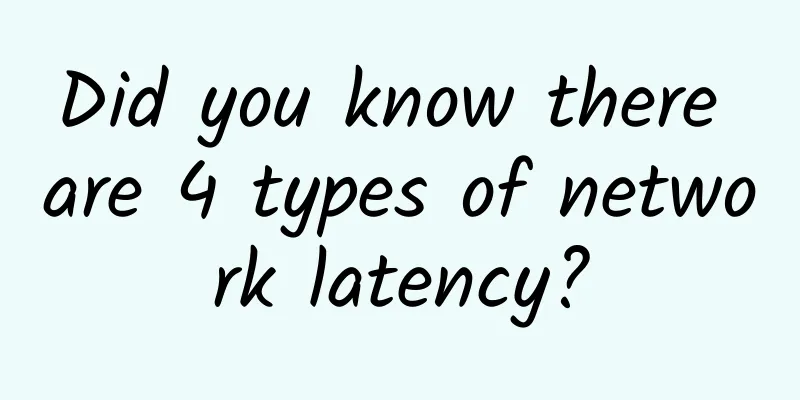Did you know there are 4 types of network latency?

|
Speaking of latency, most of us are familiar with it. High latency will greatly reduce our entertainment experience. For example, you are PKing with your enemy in a game, and suddenly the network slows down. You watch others keep hacking at you, but you can only dodge slowly, and sometimes you can't even move. This experience is really sour.
For network devices, latency refers to the total transmission time of a frame from the source to the destination, including the processing time of all nodes in the network and the propagation time on the transmission medium. Its calculation method is also very simple. You only need to add timestamp T1 when sending and timestamp T2 when receiving, and then T2-T1 to get the latency of the entire frame transmission, as shown in the figure below: Delay = T2-T1 This is actually a very easy thing to understand, but it becomes complicated after considering the length of the message. We all know that a message has a length. So when timestamping, should it be done on the first bit of the message or on the last bit? In order to distinguish between sending and receiving, the delay is divided into four types:
As shown in the following figure: Considering the delay of frame length In order to measure the latency, the standards organization has a special test item in RFC2544 to uniformly measure the latency of network equipment. If you want to measure the delay professionally, you need a professional test instrument. For example, the instrument below can measure 4 types of delay, as shown in the following figure: Professional instrument measurement delay Friends, please first understand this simple time delay. Only professionals can perform such detailed measurements. |
<<: Dynamic routing OSPF basics, area division, LSA types, one minute to understand
>>: 5G is so good, but how many people can afford the data charges?
Recommend
UK hints Huawei 5G ban may be overturned in the future
[[334143]] This article is reproduced from Leipho...
Dissecting an HTTP POST request incident
Author: Wei Ling, vivo Internet Server Team This ...
JuHost: Hong Kong VPS limited 40% off starting from $2.99/month, 1G memory, 20G SSD, 1TB monthly traffic
Last month, I shared information about JuHost, a ...
How much do you know about Zigbee wireless connection?
Zigbee has a wide range of applications and can o...
Zhao Houlin: Broadband development has made remarkable achievements, but there are still considerable challenges. The global industry needs to fully cooperate.
The digital divide has not yet disappeared, and t...
spinservers: $199/month - 2*E5-2690v4, 768GB memory, 3.84TB NVMe, 30TB/10Gbps bandwidth
spinservers is still offering discounts for some ...
Contabo: €2.99/month KVM-4GB/100G SSD/16TB/Germany, the United States, Japan and other data centers
Contabo, a long-established German hosting compan...
Quickly solve enterprise globalization network challenges and accelerate and protect enterprise cloud applications
[51CTO.com original article] On the afternoon of ...
Why don’t we have more options for in-building connectivity?
2019 was a transformational year for the telecomm...
HTTPS is a network communication protocol that protects data transmission security
HTTPS Introduction to HTTPS HTTPS (Hypertext Tran...
Boomer.Host: Cheap VPS in Houston starting at $3.50 per year (low price and low configuration)
Boomer.Host is a relatively new foreign hosting c...
The seven-layer network model and TCP, UDP, what happens in an HTTP request
[[267883]] 1. Seven-layer network model The http ...
Donghua Software——The power behind the informatization construction of Hunan Forestry Department
Recently, after attending the report meeting on t...
The Internet of Identity is coming, and IAM will undergo a major change
What is the difference between the Internet of Id...
spinservers: San Jose/Dallas high-end servers starting from $79/month, 10Gbps bandwidth, support Alipay/WeChat
spinservers sent a promotional plan for this Chri...









